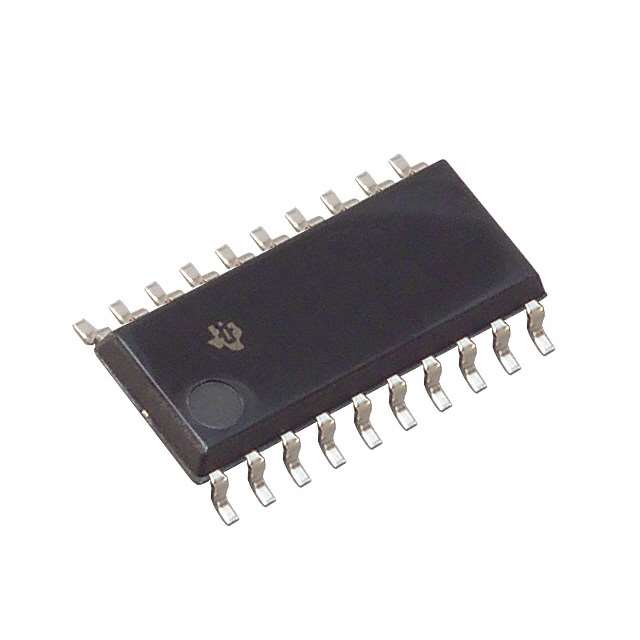SN74ALVCH245NSR
Product Overview
- Category: Integrated Circuit (IC)
- Use: Level Shifter and Bus Transceiver
- Characteristics: High-speed, low-power, bidirectional voltage level translator
- Package: 20-pin small-outline integrated circuit (SOIC)
- Essence: Translates signals between different voltage levels in digital systems
- Packaging/Quantity: Tape and reel packaging, 2500 units per reel
Specifications
- Supply Voltage Range: 1.65V to 3.6V
- Input Voltage Range: 0V to VCC
- Output Voltage Range: 0V to VCC
- Maximum Operating Frequency: 400 MHz
- Number of Channels: 8
- Input/Output Type: Tri-State
- Logic Family: ALVC/VHC
- Propagation Delay: 2.5 ns (Max)
- Low Power Consumption: ICC = 4 μA (Max)
Detailed Pin Configuration
The SN74ALVCH245NSR has a total of 20 pins. The pin configuration is as follows:
- OE (Output Enable) - Active LOW output enable input
- A1 - Data input/output for channel 1
- B1 - Data input/output for channel 1
- A2 - Data input/output for channel 2
- B2 - Data input/output for channel 2
- A3 - Data input/output for channel 3
- B3 - Data input/output for channel 3
- GND - Ground
- B4 - Data input/output for channel 4
- A4 - Data input/output for channel 4
- B5 - Data input/output for channel 5
- A5 - Data input/output for channel 5
- B6 - Data input/output for channel 6
- A6 - Data input/output for channel 6
- B7 - Data input/output for channel 7
- A7 - Data input/output for channel 7
- B8 - Data input/output for channel 8
- A8 - Data input/output for channel 8
- VCC - Power supply voltage
- DIR - Direction control input
Functional Features
- Bidirectional voltage level translation between two different voltage domains
- Allows interfacing between devices operating at different logic levels
- Supports both 3.3V and 2.5V systems
- Provides eight channels for data transmission
- Tri-state outputs allow multiple devices to share a common bus
Advantages and Disadvantages
Advantages: - High-speed operation - Low power consumption - Wide supply voltage range - Easy integration into digital systems - Bidirectional communication capability
Disadvantages: - Limited number of channels (8) - Requires careful consideration of voltage compatibility
Working Principles
The SN74ALVCH245NSR is designed to translate signals between two voltage domains in digital systems. It uses a combination of MOSFETs and CMOS technology to achieve bidirectional voltage level shifting. The direction of data flow is controlled by the DIR pin. When DIR is HIGH, data flows from A to B, and when DIR is LOW, data flows from B to A.
Detailed Application Field Plans
The SN74ALVCH245NSR is commonly used in various applications, including:
- Microcontroller interfacing with different voltage peripherals
- Level shifting in mixed-voltage systems
- Bus transceiver in communication protocols such as I2C and SPI
- Voltage level translation in battery-powered devices
- Interface between different logic families
Detailed and Complete Alternative Models
- SN74LVC245A: Similar functionality with lower power consumption
- SN74LVCH16245A: 16-channel bidirectional voltage level translator
- SN74AVC4T245: 4-channel voltage level translator with integrated level shifting capabilities
- SN74HCT245: Octal bus transceiver with non-inverting outputs
These alternative models offer similar features and can be considered based on specific application requirements.
Word count: 411 words
قم بإدراج 10 أسئلة وإجابات شائعة تتعلق بتطبيق SN74ALVCH245NSR في الحلول التقنية
Sure! Here are 10 common questions and answers related to the application of SN74ALVCH245NSR:
Q: What is SN74ALVCH245NSR? A: SN74ALVCH245NSR is a bidirectional octal bus transceiver with 3-state outputs, commonly used in digital systems.
Q: What is the voltage range supported by SN74ALVCH245NSR? A: SN74ALVCH245NSR supports a voltage range of 1.65V to 3.6V.
Q: Can SN74ALVCH245NSR be used for level shifting between different voltage domains? A: Yes, SN74ALVCH245NSR can be used for level shifting between different voltage domains due to its wide voltage range.
Q: How many bidirectional channels does SN74ALVCH245NSR have? A: SN74ALVCH245NSR has 8 bidirectional channels, allowing for parallel data transfer.
Q: What is the maximum data rate supported by SN74ALVCH245NSR? A: SN74ALVCH245NSR supports a maximum data rate of 400 Mbps.
Q: Can SN74ALVCH245NSR handle hot-swapping of devices? A: Yes, SN74ALVCH245NSR has 3-state outputs that allow for hot-swapping of devices without causing bus contention.
Q: Is SN74ALVCH245NSR compatible with both TTL and CMOS logic levels? A: Yes, SN74ALVCH245NSR is compatible with both TTL and CMOS logic levels, making it versatile for various applications.
Q: Can SN74ALVCH245NSR be used in both input and output modes? A: Yes, SN74ALVCH245NSR can be used in both input and output modes, allowing bidirectional data transfer.
Q: What is the power supply voltage required for SN74ALVCH245NSR? A: SN74ALVCH245NSR requires a power supply voltage of 1.65V to 3.6V.
Q: Is SN74ALVCH245NSR available in surface mount packages? A: Yes, SN74ALVCH245NSR is available in surface mount packages like SOIC and TSSOP, making it suitable for compact designs.
Please note that these answers are general and may vary depending on specific application requirements.


